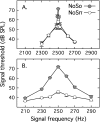The role of off-frequency masking in binaural hearing
- PMID: 20550265
- PMCID: PMC2896409
- DOI: 10.1121/1.3377053
The role of off-frequency masking in binaural hearing
Abstract
The present studies examined the binaural masking level difference (MLD) for off-frequency masking. It has been shown previously that the MLD decreases steeply with increasing spectral separation between a pure tone signal and a 10-Hz wide band of masking noise. Data collected here show that this reduction in the off-frequency MLD as a function of signal/masker separation is comparable at 250 and 2500 Hz, indicating that neither interaural phase cues nor frequency resolution are critical to this finding. The MLD decreases more gradually with spectral separation when the masker is a 250-Hz-wide band of noise, a result that implicates the rate of inherent amplitude modulation of the masker. Thresholds were also measured for a brief signal presented coincident with a local masker modulation minimum or maximum. Sensitivity was better in the minima for all NoSpi and off-frequency NoSo conditions, with little or no effect of signal position for on-frequency NoSo conditions. Taken together, the present results indicate that the steep reduction in the off-frequency MLD for a narrowband noise masker is due at least in part to envelope cues in the NoSo conditions. There was no evidence of a reduction in binaural cue quality for off-frequency masking.
Figures




Similar articles
-
Effects of non-simultaneous masking on the binaural masking level difference.J Acoust Soc Am. 2011 Feb;129(2):907-19. doi: 10.1121/1.3514528. J Acoust Soc Am. 2011. PMID: 21361448 Free PMC article.
-
Binaural modulation masking.J Acoust Soc Am. 1991 Mar;89(3):1340-9. doi: 10.1121/1.400657. J Acoust Soc Am. 1991. PMID: 2030221
-
Individual differences in the masking level difference with a narrowband masker at 500 or 2000 Hz.J Acoust Soc Am. 2007 Jan;121(1):411-9. doi: 10.1121/1.2400849. J Acoust Soc Am. 2007. PMID: 17297796 Free PMC article.
-
Combination of binaural and harmonic masking release effects in the detection of a single component in complex tones.Hear Res. 2018 Mar;359:23-31. doi: 10.1016/j.heares.2017.12.007. Epub 2017 Dec 14. Hear Res. 2018. PMID: 29310976
-
The masking level difference for signals placed in masker envelope minima and maxima.J Acoust Soc Am. 2003 Sep;114(3):1557-64. doi: 10.1121/1.1598199. J Acoust Soc Am. 2003. PMID: 14514209
Cited by
-
Systemic cisplatin increases the number of patients showing positive off-frequency masking audiometry.PLoS One. 2023 Jul 6;18(7):e0287400. doi: 10.1371/journal.pone.0287400. eCollection 2023. PLoS One. 2023. PMID: 37410731 Free PMC article.
-
The effect of interaural fluctuation rate on correlation change discrimination.J Assoc Res Otolaryngol. 2014 Feb;15(1):115-29. doi: 10.1007/s10162-013-0426-8. Epub 2013 Nov 21. J Assoc Res Otolaryngol. 2014. PMID: 24258458 Free PMC article.
References
-
- ANSI (2004). ANSI S3.6–2004, American National Standard Specification for Audiometers (American National Standards Institute, New York: ).
-
- Bos, C. E., and de Boer, E. (1966). “Masking and discrimination,” J. Acoust. Soc. Am. JASMAN 39, 708–715.10.1121/1.1909945 - DOI
Publication types
MeSH terms
Grants and funding
LinkOut - more resources
Full Text Sources

